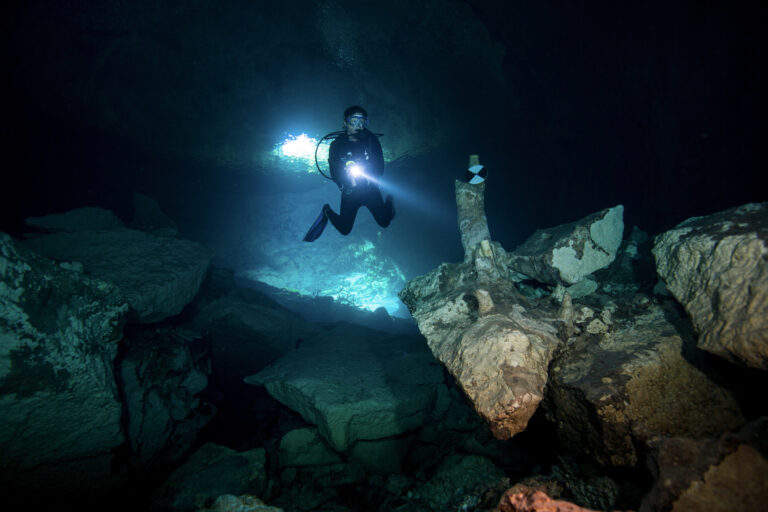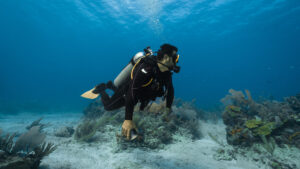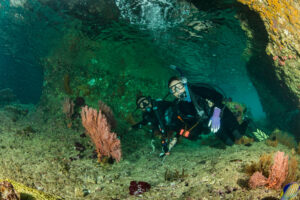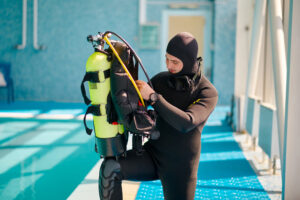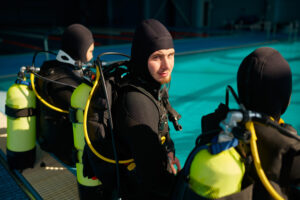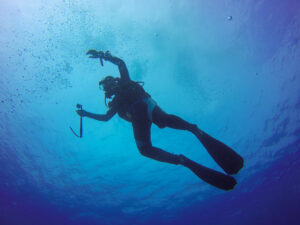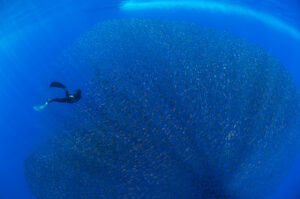What is Ingassing?
Ingassing refers to the process by which gases dissolve into the body’s tissues and blood during scuba diving. This process is crucial to understand because it affects how divers must manage their time underwater and the ascent to the surface to avoid serious health risks. The term “ingassing” is often used in conjunction with its counterpart, “outgassing,” which describes the release of gases from the body. Both processes are central to diving physiology and safety, playing a vital role in dive planning and execution.
Basic Principles of Ingassing
Ingassing occurs due to the increased pressure underwater, which causes gases, primarily nitrogen, to dissolve into the diver’s tissues. According to Henry’s Law, the amount of gas that dissolves in a liquid is proportional to the pressure of the gas above the liquid. As a diver descends, the pressure increases, leading to more nitrogen being absorbed into the body.
This process is different from outgassing, where the dissolved gases are released from the tissues as the pressure decreases during ascent. Both ingassing and outgassing must be carefully managed to prevent decompression sickness, also known as “the bends.” This condition occurs when dissolved gases come out of solution too quickly, forming bubbles in the body that can cause severe pain and other serious medical issues.
Understanding the principles of partial pressure is essential to comprehending ingassing. Partial pressure refers to the pressure exerted by a single type of gas in a mixture of gases. In the context of scuba diving, the partial pressure of nitrogen increases with depth, leading to greater absorption by the body’s tissues. Divers must be aware of these principles to safely plan their dives and ascents.
Physiological Process of Ingassing
When a diver breathes compressed air at depth, the increased pressure causes nitrogen to be absorbed more rapidly into the blood and tissues. This absorption process continues until the tissues are saturated with nitrogen, a state known as equilibrium. The rate at which nitrogen is absorbed depends on several factors, including the depth of the dive, the duration, and the individual diver’s physiology.
The body’s tissues absorb nitrogen at different rates. For instance, fatty tissues absorb and release nitrogen more slowly than other types of tissues. This variability means that different parts of the body can be at different levels of saturation at the same time, which complicates the management of ingassing and outgassing.
The concept of half-times is also important in understanding ingassing. A tissue’s half-time is the time it takes for that tissue to become half-saturated with nitrogen. Divers use this concept to estimate how long they can stay at a certain depth without exceeding safe limits for nitrogen absorption. This knowledge is essential for creating safe dive profiles and ensuring that divers do not stay underwater too long or ascend too quickly, which can lead to decompression sickness.
Role of Ingassing in Dive Planning
Proper management of ingassing is critical in dive planning to prevent decompression sickness. Divers must calculate how long they can safely stay at various depths and how to ascend without causing nitrogen bubbles to form in their tissues. This calculation involves understanding dive tables or using dive computers, which are designed to track nitrogen absorption and provide safe limits for divers.
Dive profiles, which are plans for the depth and duration of a dive, are essential tools in managing ingassing. A well-planned dive profile helps ensure that divers do not exceed the safe limits of nitrogen absorption. Divers must also consider safety stops, which are pauses at specific depths during the ascent to allow the body to release nitrogen gradually. These stops are crucial in preventing the formation of bubbles in the tissues.
Understanding the concept of no-decompression limits (NDLs) is also essential. NDLs are the maximum times that divers can stay at certain depths without needing to make decompression stops during their ascent. Exceeding these limits requires careful management of the ascent to avoid decompression sickness. Dive computers have made this process easier by continuously calculating NDLs and suggesting appropriate safety stops.
Equipment and Technology Related to Ingassing
Diving equipment and technology play a significant role in managing ingassing. Modern dive computers are essential tools that help divers track their nitrogen absorption in real time. These devices use algorithms based on dive tables to monitor the diver’s depth, time, and ascent rate, providing warnings and recommendations to ensure safe diving practices.
Rebreathers are another important piece of equipment related to ingassing. Unlike traditional scuba gear, rebreathers recycle exhaled air by removing carbon dioxide and adding oxygen, allowing divers to stay underwater longer with reduced nitrogen absorption. This technology is particularly useful for deep and technical diving, where managing ingassing is even more critical.
Diving suits also play a role in managing ingassing. Dry suits and wetsuits help maintain the diver’s body temperature, which can affect the rate of nitrogen absorption. Cold water can slow down the body’s metabolism, potentially reducing the rate at which nitrogen is absorbed. Therefore, appropriate thermal protection is crucial for managing ingassing, especially in colder diving environments.
Challenges and Considerations
Managing ingassing presents several challenges and considerations for divers. One major challenge is individual variability in how divers absorb and release nitrogen. Factors such as age, fitness level, and body composition can all affect ingassing, making it difficult to create one-size-fits-all guidelines. Divers must be aware of their own limits and adjust their dive plans accordingly.
Another consideration is the impact of repetitive diving on ingassing. Divers who make multiple dives in a short period must be especially cautious, as residual nitrogen from previous dives can accumulate and increase the risk of decompression sickness. Dive computers and tables account for this by providing adjusted limits for repetitive dives, but divers must still be vigilant about their cumulative nitrogen levels.
Environmental factors also play a role in managing ingassing. Cold water, strong currents, and strenuous activity can all affect how the body absorbs and releases nitrogen. Divers must consider these factors when planning their dives and be prepared to adjust their plans if conditions change. Proper training and experience are essential in recognizing and responding to these challenges.
Implications of Ingassing for Long and Deep Dives
Long and deep dives present unique challenges for managing ingassing. At greater depths, the partial pressure of nitrogen increases significantly, leading to more rapid absorption. This means that divers must be particularly cautious about their time at depth and their ascent rates to prevent decompression sickness.
Technical diving, which often involves depths beyond recreational limits, requires special procedures and equipment to manage ingassing. Technical divers use mixed gases, such as trimix (a mixture of oxygen, nitrogen, and helium), to reduce the amount of nitrogen absorbed. Helium, being less soluble in body tissues, reduces the risk of decompression sickness. However, the use of mixed gases requires advanced training and careful planning.
Extended bottom times also require careful management of ingassing. Divers may need to perform staged decompression, where they ascend in stages, pausing at various depths to allow their bodies to release nitrogen slowly. These decompression stops can be time-consuming but are essential for preventing decompression sickness. Technical divers often carry additional tanks with different gas mixtures to optimize their decompression stops and reduce the overall risk.
Key Takeaways
Understanding ingassing is fundamental to safe scuba diving. It involves the absorption of gases, primarily nitrogen, into the body’s tissues and blood under increased pressure. Proper management of ingassing is essential to prevent decompression sickness, requiring careful planning of dive profiles, the use of dive computers, and adherence to safety procedures. Knowledge of the physiological processes, individual variability, and environmental factors is crucial for divers to safely navigate the underwater environment.

